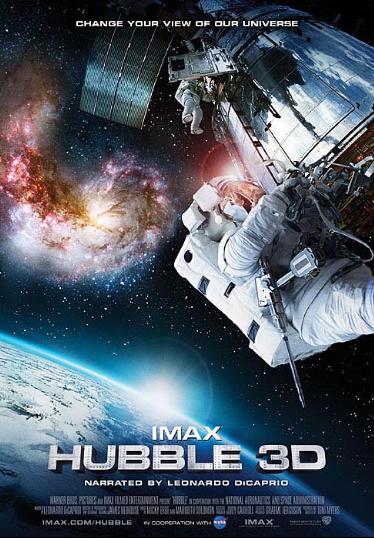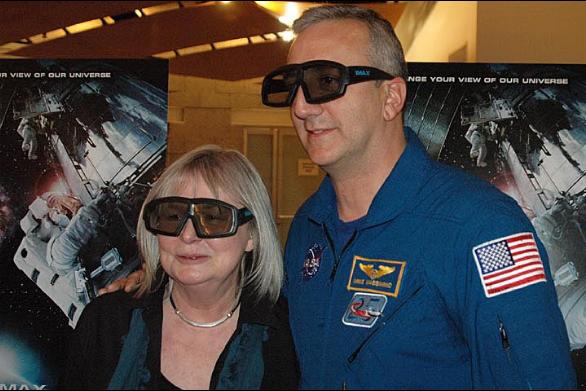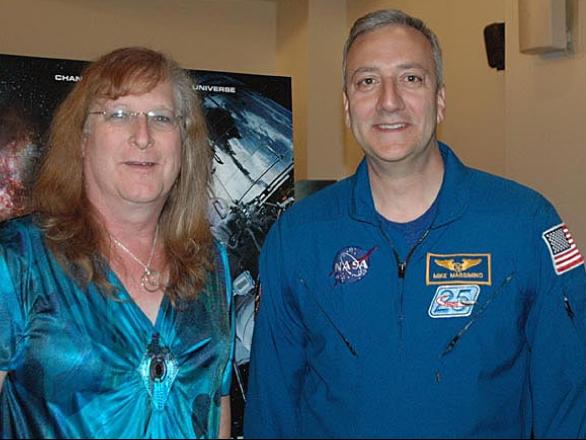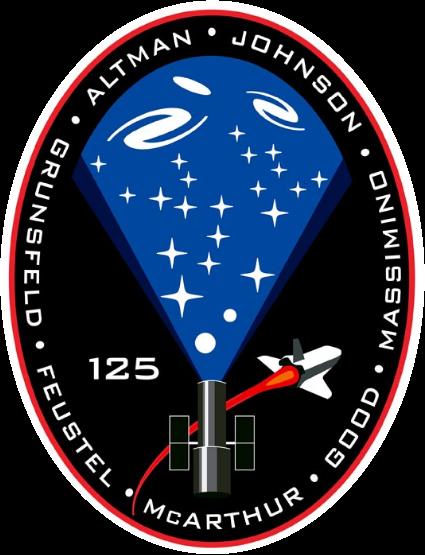 |
|||||||||||||||
STORY LINK: "HUBBLE 3D" on Space Daily |
||||||||||||||||||||||
A View From the Top "Hubble 3D" comes to IMAX theaters on March 19 by Michelle Evans, March 2010
“I knew we were going somewhere,” Hubble Space Telescope (HST) repair astronaut Michael Massimino told me recently, when asked what it’s like to launch aboard the Space Shuttle. “You just hold on and let’s try to enjoy it because you really can’t do much about it anyway!”
His latest mission was designated STS-125 aboard Atlantis, and it was slated to be the final flight to service Hubble before the Shuttle retires at the end of 2010. Mass, as he is more frequently called, was trained to climb around, and even inside, the giant orbiting observatory. He, and three of the other six crew members, would go EVA (extra-vehicular activities, or more colloquially ‘space walks’), replace large components and tiny circuit boards, making sure Hubble would have a long life after humans could no longer visit.
This would be his second mission to HST, so he was certainly familiar with the territory, but a unique aspect of this flight would also allow people from all around the world to share his experiences, in as close a way as is possible on Earth, through the wonders of IMAX 3D technology.
IMAX and the space program go hand-in-hand. These giant screen movies have been recording rocket launches and space exploration since the 1970s in precise and stunning detail, to be shown at science centers and large cinema multiplexes around the world. Titles such as Hail Columbia, The Dream is Alive, and Destiny in Space, are IMAX benchmark films in documenting the beauty and grandeur of space for the public audience. It is literally the closest many of us will ever get to understanding just a sliver of what it might be like to be weightless in space.
In April 2002, a new era dawned with the release of the IMAX movie, Space Station 3D. The 3D process took viewers inside the construction and habitation of the International Space Station, in all three dimensions! We truly had the opportunity, in a vicarious way, to float in space and see our Earth from orbit. Now, the follow up to that highly successful film is the latest from IMAX: Hubble 3D.
Toni Myers is the force behind the film, being its producer, director, and writer. “I started pitching it in 2006,” she told me, “once the final repair mission was actually a go. I knew then that I could try to get a camera on board. Prior to that they were just talking about dropping [Hubble] out of the sky. That was horrible.”
This was the expected fate of Hubble after the tragic loss of Columbia on February 1, 2003. Then NASA Administrator Sean O’Keefe, made the decision to ban future flights of the Space Shuttle to destinations other than the International Space Station (ISS). A public uproar, along with a very vocal one from the science community, kept the idea alive of going back to Hubble. Confidence was regained, and a daring rescue idea was proposed that could save stranded astronauts who did not have the safe haven of the ISS. Mission STS-125 to visit Hubble was back on the books.
Literally the same day as the mission was announced by new NASA Administrator, Michael Griffin, the crew that would fly on orbit was also announced. It included Mass, and he couldn’t have been more ecstatic to be returning. He explained how, “my perception of the Earth changed [on my first flight]. We’re not the protected place I thought we were. You kind of think you’re inside this safe little house, but really, when you see it from up there, you see this fragile, this beautiful place that we live, but it’s also amongst all this other chaos.” And including an IMAX camera to record the experience this time made it even more special to be able to share that sense of fragility and beauty.
Hubble 3D takes us further into space than any motion picture has done before. We not only follow the final servicing mission crew on its paces through training, and then the real thing on orbit, we get to go out deep into space, literally to the edge of the known universe, where the Hubble Space Telescope has photographed the strange and bizarre in ultimate detail.
For myself, I admit of expectations to see beautiful imagery in this movie. What IMAX has not delivered on that? I anticipated it would include many gorgeous photographs of the heavens, blown up to giant IMAX screen size, but even then, in all candor, this movie went far beyond my high expectations. To say that I was in awe with my jaw on the theater floor, would be an understatement.
Early in the film we see a beautiful Hubble image of the famous constellation of Orion, including the famous M-42 nebula that is a vast star-forming region, and just around the corner from us on a galactic scale. What we have never seen before is that we will now go far beyond just a pretty photograph. Here we actually travel—in 3 dimensions—to Orion! Imagine the dark of deep space, interspersed with blazing and multi-hued stars. In the distance we see the brilliant colors of the nebula. I expect us to move toward the photo and see it in stunning detail, but we keep going, far beyond anything I believed possible.
We get closer and closer. Stars between Earth and Orion slide past just as they would if warp speed was a reality. The three stars in Orion’s belt are bright and inspiring, but what holds our attention is the nebula, rapidly rushing toward us. Our view is of the angle we have come to expect from Earth, but as our “flight” arrives in the region, we are able to swoop and glide as we dive down into the glowing gases where stars and planets, whole solar systems, are forming before our eyes. We move into the radiance and are now in a deep canyon light years across; bridges and arcs and spirals. We are there, in a spot no human eye may ever see, but just as it actually would appear if that were ever possible. Giant bubbles of gas being blown away by the star formation, look like they are ready to burst their gossamer skins. Deep inside some of these bubbles, dark dust pulls together, eventually forming a star with its planetary family. Maybe in the unfathomable future we will share our arm of the Milky Way galaxy with neighbors from Orion–if we survive in some form that long ourselves.
When the sequence ends, it takes a moment to remember to breathe.
Toni Myers talked of how this, and other Hubble sequences, made it into the film. “We worked with a great team at the Space Telescope Science Institute, led by Dr. Frank Summers; and worked with a team down at the University of Illinois Supercomputing Center led by Dr. Donna Cox. That’s all real Hubble data, not computerized special effects. Hubble has captured a huge, huge data set—I’ve forgotten how many thousands of pixels it is across, but it’s massive. You pick key frames of where you want to go, so you plan a flight through trial and error, flying literally through the data.”
We return to the world of our tiny Earth, as we watch all that must be accomplished with men and women going into space to repair and refurbish Hubble. Training underwater in Houston, then travel to Florida where they enter the Space Shuttle to be blasted into space, tracking and capturing Hubble to give it new electronics and more thermal protection to extend its life, and new eyes to extend its reach to ever greater distances and greater detail.
Mass told me of the tiny details that would open up the immensity of the universe, “One thing that was different [on this final servicing mission] was the type of tasks we tried. Generally, what we do on Hubble is we take a big giant thing out and we replace it with a whole replacement big giant thing. Kind of like ‘I’ve run out of gas, get rid of the engine!’ The light bulb in the fridge don’t work, throw out the refrigerator, don’t replace the light bulb. [On this mission] we came up with a plan to go inside this instrument to replace a circuit board. I had 117 small screws to remove from an access panel and then remove the power supply, which looked like a computer board, then put a new one in. So it was an involved process.”
After seeing the film at its west coast premiere at the California Science Center in Los Angeles, Mass feels that Hubble 3D truly captures space as nothing has before. “The frustrating thing I’ve had as an astronaut is when I see all these beautiful things that I can’t have my wife and children and niece, and all of you in there with me. Now I don’t have to worry as much about that. I can actually share this with them. I can sit next to my wife and kids and friends, and watch this movie. We’re not really in space, but we’re as close as we can get.”
I suggested to Toni that the way the Hubble data is presented in her movie may open up new possibilities for fostering new science, not just entertainment. “Absolutely,” she agreed. “The folks at the Space Telescope Science Institute were thrilled. They’re now on a campaign to switch their entire data set to 3D. I had no way of really knowing how successful it would be, no idea until I saw this two weeks ago how amazing it was. I certainly talked to some astronomers that were extremely excited by it. My hope was really to inspire young people, to engender more curiosity in them, and hope they pursued careers in science and, perhaps, astronomy. That would make me very happy.”
By the time the movie ends we have travelled literally to the edge of our universe, and seen the people who put their lives on the line to do their jobs and fly into space to help make this all happen. The crew of STS-125 did fantastic work as filmmakers to bring the footage back to Earth so Hubble 3D writer and director Toni Myers and her crew could create this vision for us all.
Getting kids excited about science is a difficult task, but Mass believes Hubble 3D may open a new window of opportunity. His daughter watched a trailer for Hubble 3D while watching Avatar, also in IMAX 3D. He said, “At the end was [the credit] ‘Narrated by Leonardo DiCaprio.’ So my daughter turns to me and says, ‘No way! Does this mean he’s going to say our name?’ For me, I was very excited about seeing myself in 3D because I finally got my kids excited about something that I’m doing! And [DiCaprio] did say my name.”
Here is a whole cosmos opened up as never before, something that has to be seen and experienced firsthand, immersed in a showing at your local IMAX theater, to be properly appreciated. With the billions and more stars revealed through Hubble’s eyes, giving this production a five-star rating seems somehow to be nary enough. XXXX |
||||||||||||||||||||||
 |
||||||||||||||||||||||
 |
||||||||||||||||||||||
|
||||||||||||||||||||||
 |
||||||||||||||||||||||
|
||||||||||||||||||||||
 |
||||||||||||||||||||||
|
||||||||||||||||||||||